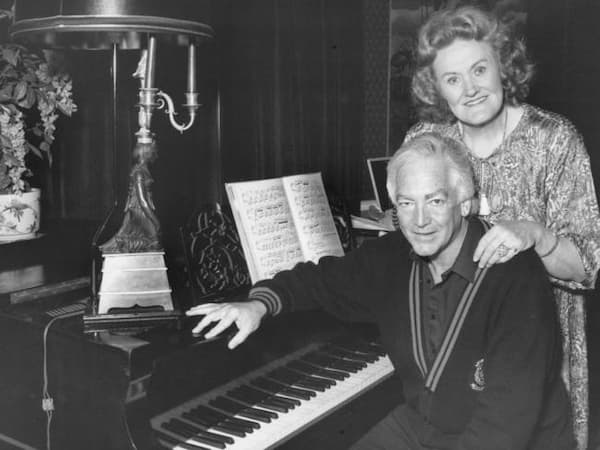Luciano Pavarotti once called her “The Voice of the Century,” and during a career spanning more than four decades, she was universally known as “La Stupenda,” The Stupendous One.” Joan Sutherland’s radiant soprano effortlessly stretched over more than three octaves, “with a purity of tone that made her one of the most celebrated opera singers of all time.” Possessing a voice combining agility, accurate intonation and a strong upper register, Sutherland was the first Australian to win a Grammy Award in 1961.
Joan Sutherland Sings Donizetti: Lucia di Lammermoor, “Eccola!”
Early Talent

Dame Joan Sutherland
Joan Sutherland was born on 7 November 1926 in Sydney, Australia, the daughter of parents with deep Scottish roots. Her father William Sutherland, an older widower who had four children from a previous marriage, married Muriel Alston, twenty years his junior. Muriel Alston had seriously trained as a mezzo-soprano but never pursued a professional career in music. Apparently, Joan spent many hours curled up under the piano and listened to her mother’s singing.
As she relates in her autobiography, “I was able from the age of 3 to imitate her scales and exercises. As she was a mezzo-soprano, I worked very much in the middle area of my voice, learning the scales and arpeggios and even the dreaded trill without thinking about it. The birds could trill, so why not I? I even picked up her songs and arias and sang them by ear, later singing duets with her; I always had a voice.”
Gioachino Rossini: Semiramide, Act I: Bel raggio lusinghier (Joan Sutherland, soprano; Royal Opera House Chorus, Covent Garden; Royal Opera House Orchestra, Covent Garden; Francesco Molinari-Pradelli, cond.)
Family Tragedy

The young Joan Sutherland
The innocence of childhood was shattered by the death of her father. On Joan’s 6th birthday, her father took her for a swim at the beach on Sydney Harbour, exactly 111 stone steps below their home at Point Piper. Once they made it back up the stairs, William collapsed and died from a heart attack. Her father had been a master tailor, and his death left the family in deep financial trouble during the Depression.
In addition, Joan Sutherland was not a healthy child. She was plagued by chronic sinusitis, ear infections and bad teeth from around the age of 5. Suspecting that her tonsils might be the problem, her mother took her to a specialist who proclaimed, “she has the most perfect vocal chords I have ever seen. She must have no operations that will damage them.”
Joan Sutherland Sings Bellini’s I Puritani, “Son vergin vezzosa”
Discovery

The young Joan Sutherland and her friend
With her vocal chords intact, Muriel Alston continued to teach her daughter. In fact, Joan always maintained that her “mother’s basic teaching of breathing and scales made a valuable contribution to her career.” Sutherland left school at 16 to become a secretary, but she continued her vocal studies with her mother, eventually winning a vocal scholarship at the age of 18.
The 2-year scholarship included vocal lessons with Johan and Aida Dickens. Her teachers detected in her young voice that she was trained to sing in the lower register, the makings of a dramatic soprano. Sutherland initially protested, but she eventually agreed and learned the dramatic arias of Verdi and Wagner. Sutherland modelled herself on Kirsten Flagstad and made her public debut in 1946, singing from the chorus.
Wolfgang Amadeus Mozart: Le nozze di Figaro (The Marriage of Figaro), K. 492 (excerpts) (Joan Sutherland, soprano; National Philharmonic Orchestra; Richard Bonynge, cond.)
Richard Bonynge

Joan Sutherland and Richard Bonynge
Sutherland made her concert debut as Dido in Purcell’s Dido and Aeneas in 1947, followed by various recital performances. Her accompanist on many of these occasions was a young pianist by the name of Richard Bonynge. He departed for London a few years later on a scholarship at the Royal College of Music, and Sutherland won the “Sun Aria” Competition. She also sang the title role in Sir Eugene Goosens’ Judith at its world premiere at the Sydney Conservatory.
In 1951, Sutherland and her mother left for London, and Joan enrolled at the Opera School of the Royal College of Music with Clive Carey. She was hired by the Royal Opera House at Covent Garden as a utility soprano, and she met up with Richard Bonynge once again. They were married a year later and Joan transformed into a bel canto star. Bonynge convinced her that her voice was not really suited for the Wagnerian roles she had been singing but that it was flexible enough to approach Donizetti and Bellini. She starred in the title role of “Lucia di Lammermoor” in a Covent Garden revival staged by Franco Zeffirelli in 1959, and her international career went into hyperdrive.
For more of the best in classical music, sign up for our E-Newsletter
